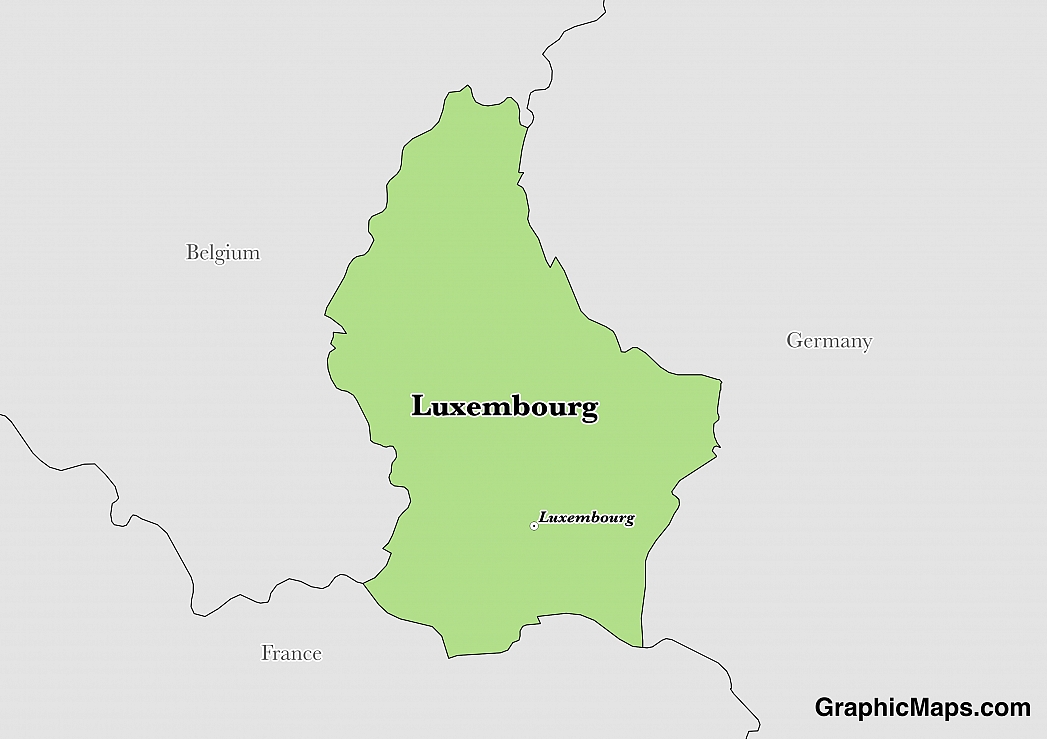Where is Luxembourg?
Located in Western Europe, Luxembourg has a 327.00 km border with Belgium (130 km), France (69 km) and Germany (128 km).
The capital of Luxembourg is called Luxembourg City. The city is located in the southern region of the Luxembourg plateau. It is situated on an uneven topography characterized by cliffs and valley. The city was developed in the 10th century as a strategic location for military defense against attacks. The climate of Luxembourg City is mild oceanic, with moderate precipitation. The population of the city as of 2016 is around 111,200. The Metropolitan population is around 180,000. The city is a rich cultural center and a top tourist destination with many cultural attractions such as museums, cemeteries and art galleries. There are a lot of places of interest that attract tourists to the city.
Read more on Luxembourg's CapitalLuxembourg is a European country covering 2,586.00 km2. This makes it the 28th smallest country in the world and slightly smaller than Rhode Island. Its geographic coordinates are 49 45 N, 6 10 E and Luxembourg is the capital city.
The name Luxembourg comes from the Celtic "lucilem" and German "burg" to produce the meaning of "little castle".
Its ISO code is LU.
Geography
Luxembourg has a mean elevation of 325 m above sea level.
It has a continental climate with mild winters and cool summers. Its terrain is mostly made up of gently rolling uplands with broad, shallow valleys and some mountains.
Population
Luxembourg has a population of 582,291 making it the 171st largest in the world. The majority of the population lives in the south.
Luxembourgish is the official language; French, Portuguese, and German are also widely spoken. The major ethnic groups identified are Luxembourger, Portuguese, and French. The majority of the population is Roman Catholic.
The national language of Luxembourg is Luxembourgish. The language belongs to the family of West German languages and Moselle Franconian languages. In ancient times, the language was considered a dialect of German. There are over 400,000 native Luxembourgish speaker in the world. The majority of the Luxembourgish language speakers live in Luxembourg with a considerable number also found in France and Germany. The language has 26 Latin letters and 3 additional diacritics. French and German are also commonly spoken in the country and have been considered official languages. English is the fourth most spoken language in the country. Luxembourgish has highly borrowed expressions and vocabulary in French and Germany to enrich its vocabulary.
Read more on Luxembourg's LanguagesThe dialing code for the country is 352.
Government
Luxembourg is an independent country. It gained independence from the Netherlands in 1839. Its constitution was last ratified in 1868.
Luxembourg has a parliamentary representative democracy. It has a hereditary monarchical system with a multi-party system. The head of the government is the prime minister, who is assisted by the deputy prime minister. The Grand Duchy, the hereditary position, can appoint and dismiss the premier and the deputy premier. The deputy prime minister is Etienne Schneider. Elections are held every five years to elect members of the Chambers of Deputy. The sessions of the Chamber of Deputies are held in Hôtel de la Chambre in Krautmaart while the palace is located in Central Luxembourg. ?
Read more on Luxembourg's GovernmentEconomy
Factoring in Purchasing Power Parity, Luxembourg's GDP is $58,740,000,000.00 (USD) with $102,000.00 (USD) per capita. This makes it the 106th largest economy and its citizens the 4th richest in the world. The currency of Luxembourg is the Euro (EUR).
Its major export partners are Germany, Belgium, and France. Its main exports are machinery and equipment, steel products, and chemicals. Its major import partners are Belgium, Germany, and China. Its major imports include commercial aircraft, minerals, chemicals, and metals.
Flag
The flag of Luxembourg is tricolor of horizontal stripes of red, white, and blue from top to bottom respectively. The flag is usually in the dimension of 3:5 or 1:2. The three colors of the flag were branded in 1830 during the Belgian revolution and officially designed in 1845, about ten years after independence. The colors of the flag were inspired by the Grand Dukes court of arms and by the flag of France. The red color stands for power and vibrancy of the people while the white color signifies purity and peace. The bottom blue color signifies the determination and perseverance of the Luxembourgian.
Read more on Luxembourg's FlagThis page was last modified on February 6th, 2018
More on Graphicmaps

Published on 2019-11-06
What is a Trade Embargo?

Published on 2019-11-04
Which Two Countries Used to Have the Same Flag?

Published on 2019-09-16
What Is the Only Two-Sided State Flag?

Published on 2019-09-16
Which Country Flag Looks Like the Texas Flag?

Published on 2019-08-29
Flags That Resemble the US Flag

Published on 2019-08-20
